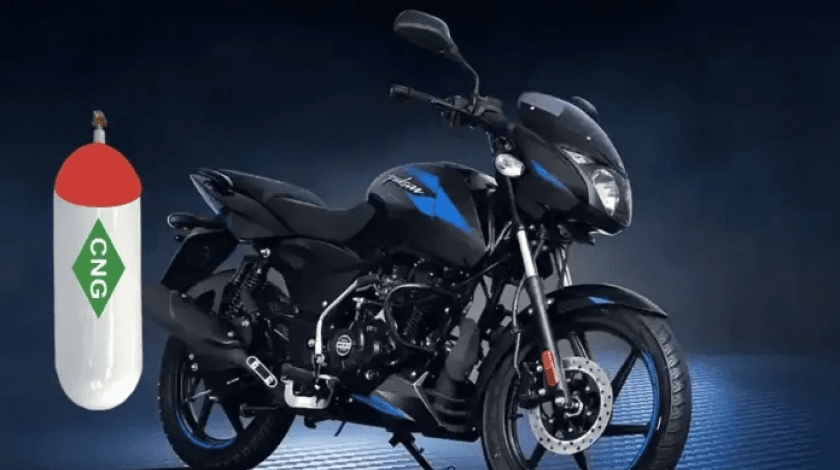Highlights of The Article
- Cost-effectiveness: CNG is cheaper than petrol and diesel, leading to significant fuel savings.
- Environmentally friendly: CNG burns cleaner, reducing emissions and aligning with India's sustainability goals.
- Potential for decent range: Advancements in technology could offer a range comparable to petrol bikes.
- Government support: Promotes alternative fuels and infrastructure development.
It seems like transportation is always changing these days. The roar of motorcycle engines in India may soon have some electric bikes joining in with a much quieter hum.
The noise from gas bikes could be getting some competition from a smoother sound as electric vehicles become more popular even in that country.
The buzz around the potential arrival of compressed natural gas (CNG) motorcycles has captured attention, offering a futuristic vision that promises affordability, cleaner emissions, and a potential revolution in the two-wheeler domain.
This article explores the world of CNG motorcycles, assesses their potential impact in India, and navigates the road ahead for these eco-friendly rides
1. Fueling the Hype: Why CNG Motorcycles?
The concept of CNG motorcycles has garnered interest due to several compelling factors:
- Cost-Effectiveness: CNG, being significantly cheaper than petrol and diesel, opens the door to substantial fuel savings per kilometre. This affordability could be a game-changer, particularly for budget-conscious riders and commercial applications.
- Environmentally friendly: CNG burns cleaner than conventional fuels, emitting fewer greenhouse gases and pollutants. This aligns seamlessly with India's commitment to cleaner transportation and addresses the environmental impact associated with traditional motorcycles.
- Range Potential: While concerns about range persist, advancements in CNG technology could potentially offer a decent range comparable to existing petrol-powered motorcycles.
2 . Shifting Gears with CNG Motorcycle: The Indian Context
India provides fertile ground for the adoption of CNG motorcycles owing to specific contextual factors:
Dominant Motorcycle Market: As the world's largest two-wheeler market with millions of motorcycles on the road, India presents a massive user base where CNG technology could provide a cleaner alternative.
- Rising Fuel Costs: Escalating petrol and diesel prices make fuel-efficient options like CNG increasingly attractive to the Indian consumer.
- Government Push: The Indian government actively promotes alternative fuels, offering subsidies and supporting infrastructure development, creating an environment conducive to the growth of CNG-powered vehicles.
3. Cost and mileage of CNG Motorcycle
CNG motorcycles, though yet to materialize in India, hold intriguing potential in terms of cost and mileage.
While concrete figures are unavailable, estimates can be drawn from existing CNG technology in three-wheelers and international CNG motorcycles. In India, CNG three-wheelers typically achieve a mileage range of 25-35 km/kg, while in countries like Pakistan and Bangladesh, CNG motorcycles deliver between 30-40 km/kg.
Considering an optimistic scenario of 35 km/kg, a hypothetical cost analysis reveals that CNG could offer nearly 40% fuel cost reduction per kilometre compared to petrol.
However, challenges such as limited infrastructure, performance concerns, and technological hurdles in integrating a CNG cylinder into motorcycle design need to be addressed for the successful adoption of CNG motorcycles in India.
4. Gearing Up for Challenges: Hurdles on the Road for CNG Motorcycle
However, several obstacles need to be overcome before CNG motorcycles become a widespread reality:
- Technology Challenges: Integrating a bulky CNG cylinder into the design of a motorcycle without compromising performance and handling poses a considerable engineering challenge.
- Infrastructure: The widespread availability of CNG refuelling stations is crucial for widespread adoption. Currently, the infrastructure for CNG is limited compared to conventional fuel stations.
- Performance: Balancing power, range, and efficiency with CNG requires innovative solutions. Achieving performance comparable to petrol bikes is crucial for broader acceptance.
- Competition: The rapid rise of electric vehicles presents stiff competition, potentially impacting the market demand for CNG bikes.
5. Revving Up the Future: What Lies Ahead for CNG Motorcycles?
While commercially available CNG motorcycles are yet to hit the Indian market, promising developments indicate potential shortly:
- Bajaj Auto's Foray: Bajaj Auto, a prominent Indian vehicle manufacturer, has expressed interest in developing CNG motorcycles, hinting at a possible 2025 launch.
- Start-up Innovations: Indian start-ups like Gas Motors and Go Green CNG are exploring CNG conversion kits for existing motorcycles, paving the way for aftermarket solutions.
- International Trends: Countries like Pakistan and Bangladesh already have commercially available CNG motorcycles, offering valuable insights and potential technology transfer opportunities.
Also, read other blogs
- Electric Two-Wheeler Financing: A Comprehensive Guide
- E-Luna Review: Your Next Electric Scooter
- Hero Vida Sway: Redefining the Electric Scooter with Two Wheels Up Front
The Final Lap: Weighing the Options
While CNG motorcycles in India are still in their nascent stage, the potential benefits of affordability, cleaner emissions, and alignment with national sustainability goals are significant. As enthusiasts await their arrival, riders can take proactive steps:
- Explore Current CNG Options: Bajaj currently offers a range of CNG-powered three-wheelers and commercial vehicles, providing an entry point to CNG technology.
- Monitor Developments: Stay updated on news and announcements from Bajaj, start-ups, and the Indian government regarding CNG motorcycles.
- Consider electric alternatives: With electric motorcycles gaining traction, environmentally conscious riders can explore zero-emission options and the growing charging infrastructure.
Remember, the journey towards a sustainable future on two wheels requires collective effort and exploration of all possible avenues. Let's keep the engine of innovation running and pave the way for a greener ride for all!
